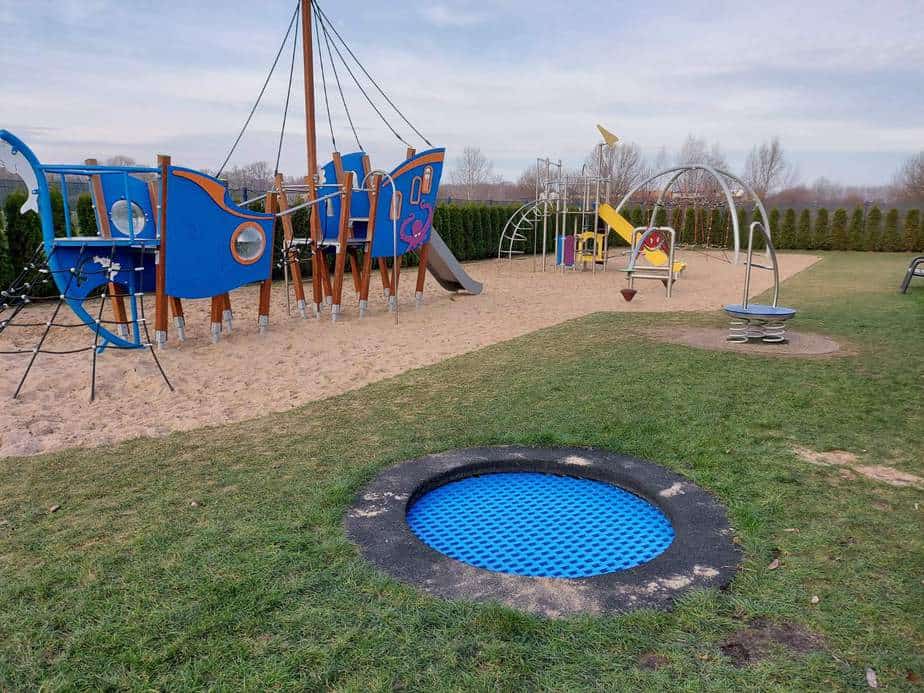Safe surfacing around trampolines – types, benefits and regulations
A trampoline is not only a structure that allows you to bounce, but it is also all the components that affect the comfort and safety of using such a device. One of the most important issues when designing an earth trampoline is to consider the appropriate surface. It is particularly important for playground administrators. Pursuant to current regulations, not every surface will be safe enough to be placed on playgrounds – so it is worth taking a closer look at them.
Standards for playground surfacing – EN 1177
The construction of playgrounds, including the surface around trampolines, is regulated by the PN-EN 1177 standard. These are regulations which help to choose the right type of surface to ensure proper shock absorption in case of a fall. The document takes into account the safety of children and the height from which one can jump onto the surface without major injuries. The PN-EN 1177 standards are on the one hand to show designers what factors to pay attention to when creating playgrounds, and on the other to ensure maximum safety for users. That is why, when commissioning the construction of playgrounds or in-ground trampolines, one should choose only companies that are able to present a certificate compliant with this standard.
Types of safety surfacing for trampolines and playgrounds
Any object intended for use by children, from which the free fall height is more than 600 mm, must have a suitable, safe surface. This also applies to swings, slides, carousels and trampolines. Using the correct surface can protect your child from permanent damage to their health or loss of life. However, this does not mean that the surface will completely eliminate the risk of injury.
The most common types of surfacing used in playgrounds are:
– rubber materials – these are generally used for ground trampolines, but some people also use them to cover entire playgrounds. Rubber can take the form of different coloured tiles in square, rectangular, triangular or many other shapes. It therefore allows freedom in playground design. It is important to ensure that the rubber surface is certified in accordance with the PN-EN 1177 standard, which will specify up to what height cushioning is provided. Alternatively, there are rubber gratings which, if properly installed, will cushion a fall from up to 3 meters, without completely covering the grass.
– loose materials – these include sand, gravel, bark or wood chips. This type of surfacing is used for equipment that does not require high stability. However, in their case, it should be taken into account that the surface should be laid up to the depth of 300 mm.
– grass – the turf of the grass area also meets the requirements of EN 1176-1. The maximum free fall height in this case is up to 1000 mm, so it can be used as an impact absorbing surface in the fall area of an in-ground trampoline.
 |
 |
Why should the surface around trampolines be suitable?
According to many playground administrators, the only reason why they have to create bases around playground equipment is because regulations require them to do so. Nevertheless, they are there for a reason. The most important reason for using appropriate surfaces on playgrounds is, above all, safety. An unfortunate fall from even a small height can cause injuries such as fractures, scratches and cuts. With the right flooring, most of these can be avoided. However, apart from legal issues, such a surface has also other applications.
The safe surface makes it possible to play even when it’s raining outside. Neither puddles nor mud form on the playground. Furthermore, such a surface also contributes to the image of the town, municipality or neighbourhood – it is made of colourful elements with impressive shapes. Once a playground has such a surface, parents are more likely to encourage their children to play there, knowing that they will play safely.
Making playground surfaces safe is not just an obligation. The selection of appropriate materials and designing the area around the equipment so that it fulfils both a protective and an aesthetic function is recommended. The safest surface are rubber materials which, due to their versatility, can be installed on virtually any playground. When used around ground trampolines or other play equipment, they will not only ensure adequate safety, but also significantly improve the aesthetic value of the playground. However, you should always make sure that the products are certified in accordance with PN-EN 1177.

